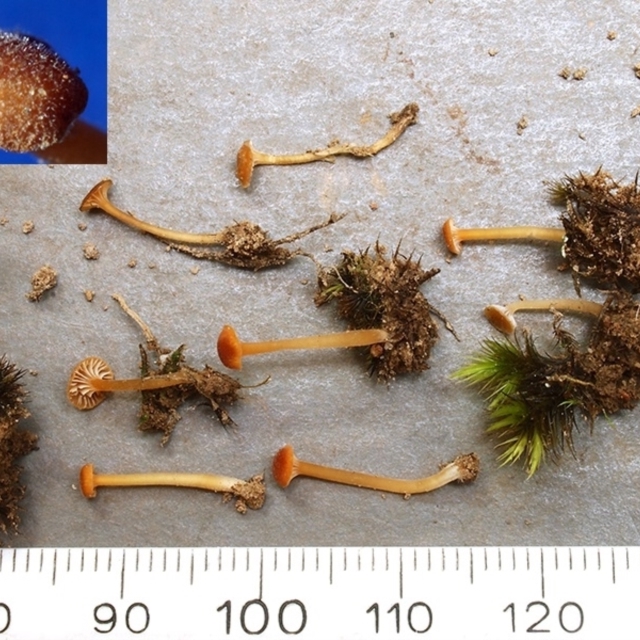Rickenella fibula
The fruitbody is a mushroom, with a cap atop a central stem. Mature caps may be as little as 3 millimetres in diameter but may grow to a little over a centimetre. The cap is deep orange and initially convex to hemispherical but later flattens (possibly even becoming a little funnel-shaped). The cap is smooth to the naked eye but is densely covered with colourless bristles (up to about a tenth of a millimetre long). The gills are whitish and extend a little down the stem (decurrent, to use the technical term). The stem is yellowish-orange to orange, 1-2 millmetres wide and up to 40 millimetres long.
There is neither a partial nor a universal veil.
Spore print: white.
This species grows on mosses, in a variety of habitats, and is found in many parts of the world.
Rickenella fibula and mosses
There is a study of the moss association in this work: H. B. Korotkin, (2017), Stable isotopes, phylogenetics, and experimental data indicate a unique nutritional mode for Rickenella fibula, a bryophyte associate in the Hymenochaetales, Master's Thesis, University of Tennessee.
From the abstract: PCR assays of the ITS region of R. fibula in moss host tissues support the presence of the fungus throughout the gametophyte tissues, including rhizoids and living and senescent portions of the moss. Lastly, in most cases, inoculation of moss gametophytes with R. fibula does not significantly impact productivity of the moss. Taken together, these results support a unique biotrophic mode in R. fibula with the fungus most likely maintaining a commensal endophytic relationship with its moss host.
Look-alikes
The orange colour and its growth on mosses rules out any confusion with most mushroom-producing species. Some species of Hygrocybe or Omphalina-like genera seem the most likely candidates for confusion, since they may be orange and appear amongst mosses. If the caps are larger (say over 15 mm) then Rickenella fibula is unlikely. The non-Rickenellas lack the cap bristles.
Rickenella fibula is listed in the following regions:
Canberra & Southern Tablelands
Species information
- Rickenella fibula Scientific name
- Common name
- Not Sensitive
- Local native
- Non-invasive or negligible
- Machine learning
Location information
-
Maps
Black Mountain




